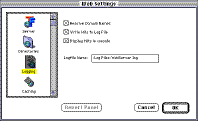Hit Logging
TeleFinder creates a file called "WebServer.log" with your web site activity in tab delimited format. This file is located within the "Log Files" folder. This logging information is also displayed in the Web Server window.This log file is compatible with at least 2 Log File Analysis programs we know of: ServerStat and "Web Stat." Both of these programs summarize the site activity in a presentable html file. Server Stat Lite is the shareware version of Server Stat.
Analog is a very fast, and free, log file report generator.
You can also import the log file into FileMaker or any other database software.
Log File Format
The format is:date, time, OK or Err!, remote address, request, bytes sent
For example:
01/17/97 11:33:06 rusty-pc.spiderisland.com / OK 1680
01/17/97 11:33:13 rusty-pc.spiderisland.com /docs/ OK 2188
Logging Options
Use the Logging pane to set the type of logging you want for activity at your web site. Select the "Server Settings" command from the Web menu to open this dialog. Then click on the "Logging" icon to display the Logging pane.

The Logging pane has four settings:
Resolve Domain Name
Turn this on so that TeleFinder will convert client IP addresses into the client's domain name ( i.e.: 199.35.3.99 to bbs.spiderisland.com ).Write Hits to Log File
Turn this on to create the tab delimited hit records in the log file.Display Hits in console
Turn this on to display the web hit information in the "Web Server Log" console window.Log File Name
Enter the name you would like TeleFinder to use as the log file name. If you want the file saved in a specific location, enter a partial or full path name for the file.Options for Enhancing Web Site Speed
Each of the previous Logging Options require extra processing time for each request. If your Web Site is extremely busy you may want to turn these options off.Turning the Logging Options off will let TeleFinder handle more hits per second with a given number of web threads.

May 14, 1997 -- ©Copyright 1997, Spider Island Software